BSOD PAGE_FAULT_IN_NONPAGED_AREA or STOP 0x00000050 blue screen of death error, commonly is occurred after the installation of a new hardware device driver, after a new software installation or update and in other cases is caused due to a corrupted NTFS volume.
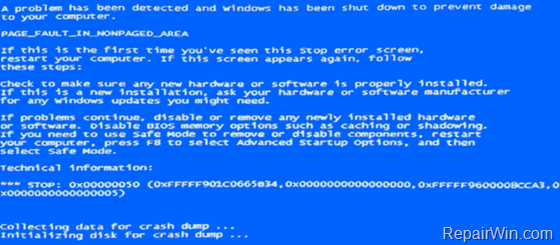
PAGE FAULT IN NONPAGED AREA blue screen problem, is a serious fault in Windows 10, 8, 7 and Vista OS, because when it appears the user cannot do anything with its PC and may loose its work. The PAGE FAULT IN NONPAGED AREA error is occurred because Windows tries without success to use the faulty device, driver or service.
How to fix the PAGE_FAULT_IN_NONPAGED_AREA STOP 0x00000050 BSOD ERROR.
Nội dung
The STOP 0x00000050 (PAGE FAULT IN NONPAGED AREA) error generally means a hardware or a Software problem. So, before troubleshooting the error by following the methods below, try the following:
1. If you have recently installed any new hardware or Software on your system, then remove it (Disconnect it) to see if this resolves the issue.
2. Navigate to Device Manager and find if any device is displayed with a yellow triangle (yellow exclamation sign). If so, then install the required device driver. (Right click on the device and select Update Driver Software). If the installation fails download the required device driver from manufacture’s support site.
3. Run Windows updates and update your Windows installation.
4. Disable or totally uninstall your Antivirus Software.
Method 1. Check the RAM MEMORY for errors.
The first step to troubleshoot the “PAGE_FAULT_IN_NONPAGED_AREA” problem, is to diagnose your memory RAM for errors by using the Windows Memory Diagnostic utility.
To launch the Windows Memory diagnostic utility in Windows 10, 8, 7 or Vista.
1. Press Windows ![]() + R keys to open the run command box.
+ R keys to open the run command box.
2. In the Search box, type: mdsched.exe & click OK.
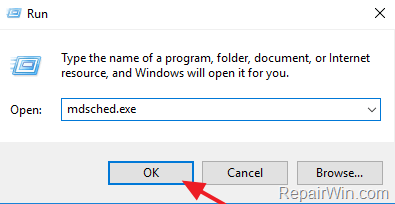
3. Choose the Restart now and check for problems (recommended) option.
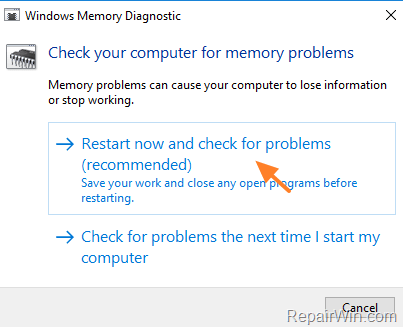
4. Wait while Windows is checking for Memory problems.
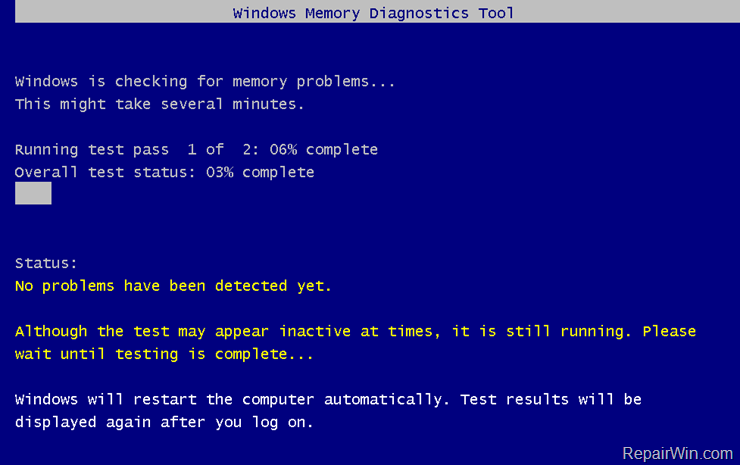
If there is any problem with your RAM, turn off your computer and try to remove and reinsert the RAM stick. Additionally if you have more that one stick installed, then remove the one of them and run the Windows Memory Diagnostics again, until you find out which one is faulty.
Method 2. Check the Hard Disk for Errors to fix PAGE_FAULT_IN_NONPAGED_AREA.
The PAGE FAULT IN NONPAGED AREA may caused from a corrupted NTFS volume, so check your disk for errors. To do that:
1. Open Command Prompt with administrative privileges.
In Windows 7 & Vista go to:
- Start > All Programs > Accessories
- Right-click at “Command prompt” item and choose “Run as administrator”.
In Windows 10, 8 & 8.1:
- Right-click at the screen’s bottom-left corner and from the pop-up menu, choose “Command Prompt (Admin)”.
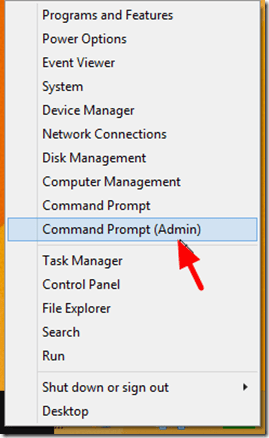
2. In the command prompt window, type the following command and press enter:
- chkdsk c: /F /R
3. Press the “Y” key in order to check your disk the next time your system restarts.
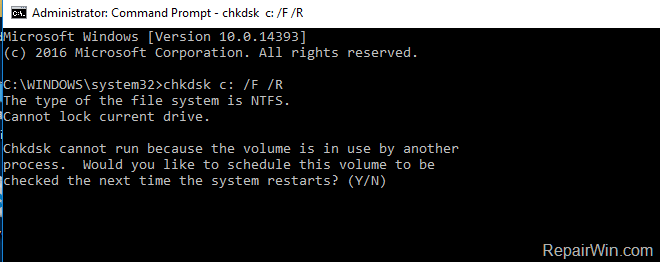
Method 3. Check Windows System Files Integrity.
Use the SFC command, to fix your system files integrity and fix the STOP 0x00000050 or PAGE_FAULT_IN_NONPAGED_AREA problem.
1. Open an elevated command prompt. (with administrative privileges)
2. In the command prompt window, type sfc /scannow and press Enter:

3. Now wait until the System File Checker repairs the Windows System Files.
4. When this done, restart your computer.
Method 4. Prevent Third Party Services from Starting at Windows Startup.
The next method to resolve the is “PAGE_FAULT_IN_NONPAGED_AREA” is to perform a Windows Clean boot. (Disable all non Microsoft services and all additional programs that run at Windows Startup). *
Note: In order to force Windows to perform a clean boot you must login to Windows by using an Administrator account.
1. Press Windows ![]() + R keys to open the run command box.
+ R keys to open the run command box.
2. In the Search box, type: msconfig & click OK.
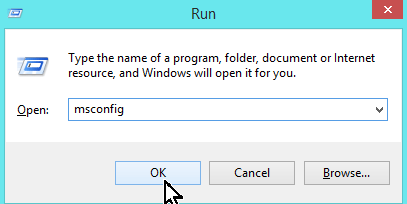
3. At Services tab, check the Hide all Microsoft Services checkbox and then press Disable All.
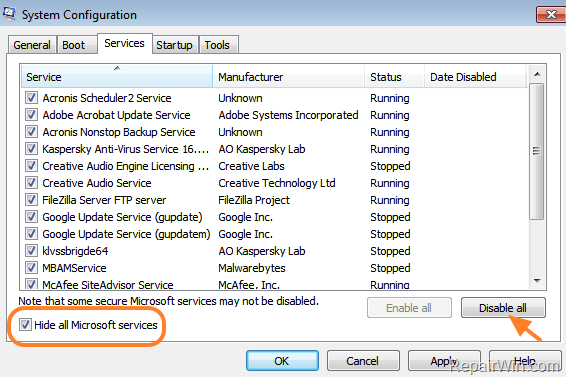
4. Then select the Startup tab and press again the Disable all button. *
Note: On Windows 10 or 8, you have to select the Open Task Manager option and then to disable one by one all listed items.
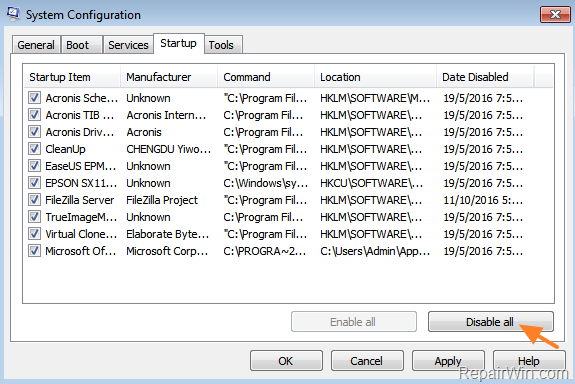
5. Click OK and Restart your computer.
6. If after restart your computer is working without the “PAGE FAULT IN NONPAGED AREA” error then – by using the system configuration utility – enable one by one the disabled services (and programs) and restart your computer, until you find out which service – or program – causes the “PAGE FAULT IN NONPAGED AREA ” error.
Method 5. Modify Virtual Memory Settings (Paging File).
In some cases the “PAGE_FAULT_IN_NONPAGED_AREA” problem may caused from invalid settings in paging file (Virtual Memory). To fix this issue:
1. Press Windows ![]() + R keys to open the run command box.
+ R keys to open the run command box.
2. Type sysdm.cpl & click OK.
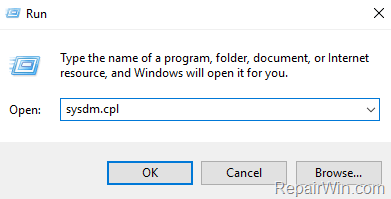
3. At Advanced tab select Performance Settings.
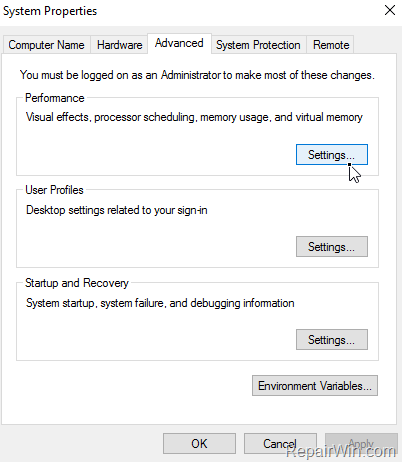
4. At Performance Options, select the Advanced tab and then click Change.
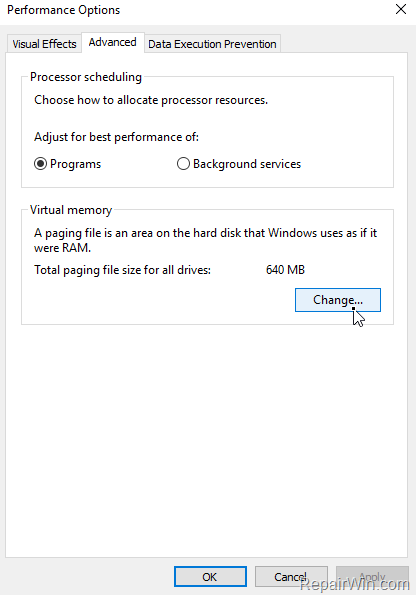
5. Uncheck the Automatically manage paging file size for all drives checkbox.
6. Select the Custom Size option.
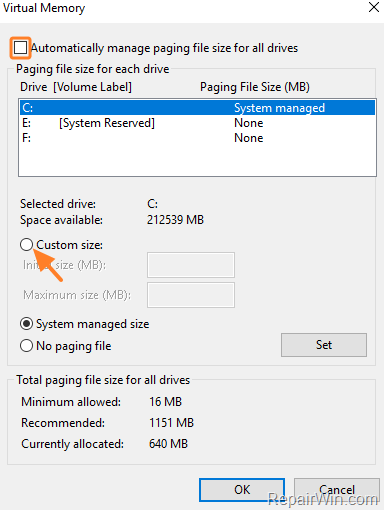
7. Now type into both the İnitial size(MB) and Maximum size(MB) box a value that is two and half times (2,5) the amount of RAM installed on your System. *
e.g. If the installed RAM memory is 2GB (2048MB) then set type: 5120 (2,5 x 2048 = 5120).
* Note: Windows limits restricts the increase to three times the amount of RAM installed on your device. If you have 4GB (or more) RAM on your system, then set the Initial and Maximum size values to two (2) times the amount of the installed RAM.
8. When done click Set and then click OK to apply changes and Restart your computer.
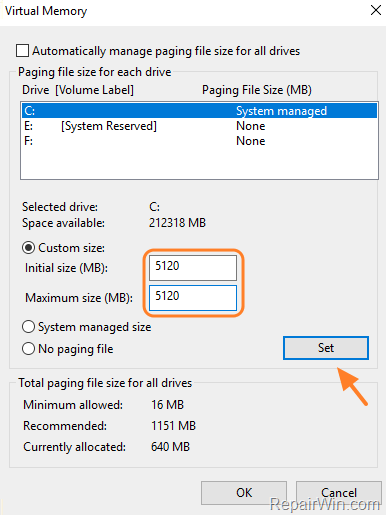
Method 6: Analyze Minidump Files.
Mindump files, are small files that created from Windows when the system crashes. The Windows minidump files are stored under C:WindowsMinidump directory and contains important details about the BSOD problem(s) or when the system becomes unresponsive. In such case(s) you can use the BlueScreenView tool developed by Nirsof, to view the minidump files and find out which driver or application causes Windows crash.
1. Download BlueScreenViewer (in Zip file) according your Windows version. *
* Note: BlueScreenView (in Zip file) doesn’t require any installation. In order to start using it.
2. Extract the ZIP file you downloaded and then run the “BlueScreenView.exe” application.
3. The program automatically will search for the MiniDump files at the default location (C:WindowsMinidump). *
* Note: If you have changed the Minidump file’s default location or you have one or more minidump files from another computer, then go to Options menu > Advanced Options and select the alternative location after pressing the Browse button.
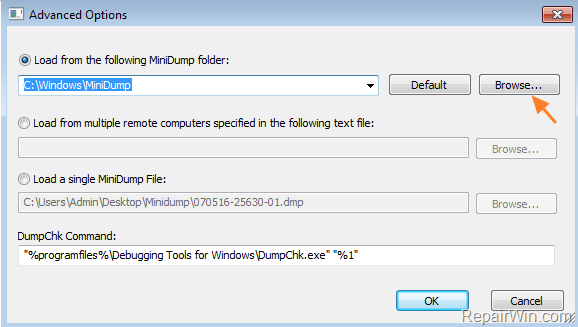
4. When BlueScreenView analyzes the minidump files, you will see the following information (details):
– At at the TOP pane:
1. The name of the Minidump file: e.g. “062916-2080-01.dmp”. At this example the “06” is the month, the “29” is the date and the “16” is the year of the dump file.
2. The crash time: e.g. 29/06/2016 3:21pm)
3. The error code (aka “Bug Check String”): e.g.: DRIVER_IRQL_NOT_LESS_OR_EQUAL
5. The STOP error (aka “Bug Check Code”): e.g.: 0x000000d1
6. The Bug Check Code parameters.
– At the LOWER pane, you will see a list of all the loaded drivers (or applications) when the BSOD error is occurred. In this list the most important details are highlighted and shows the driver (or the application) that cause the BSOD crash problem. e.g. “Ntfs.sys“
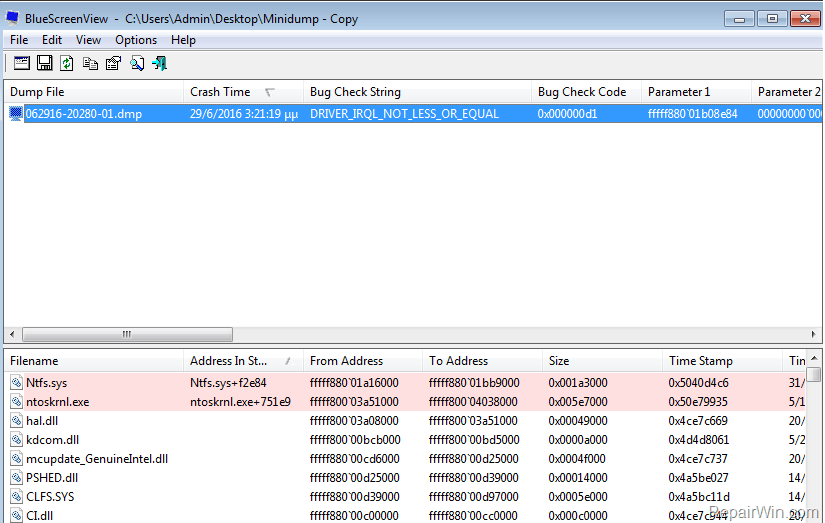
5. After viewing the BSOD Minidump information, search the web for an available solution by typing the displayed “Bug Check String”, the “Bug Check Code” and the module that causes the blue screen – crash – problem. e.g. search for “DRIVER_IRQL_NOT_LESS_OR_EQUAL Ntfs.sys” or “DRIVER_IRQL NOT LESS OR EQUAL 0x000000d1“
– Additionally: Right click at any line at the top pane and choose: “Google Search – Bug Check” or “Google Search – Bug Check+Driver” or “Google Search – Bug Check + Parameter1“.
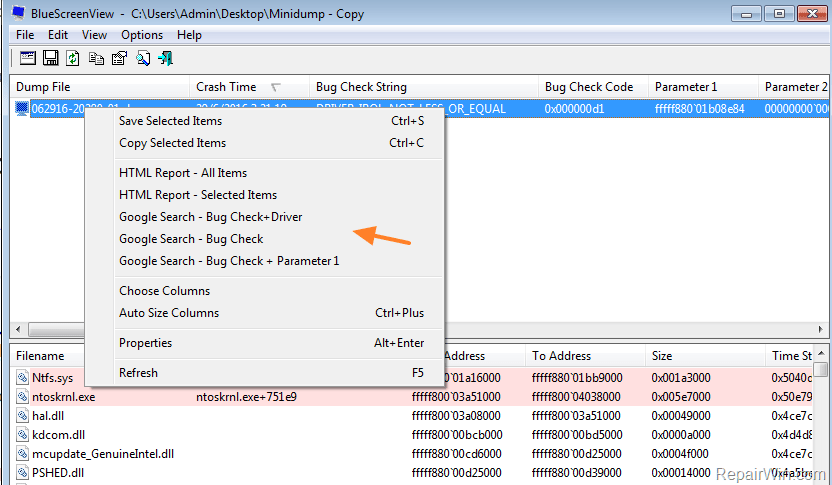
Method 7. Use System Restore.
Bug check 0x50 can occurred after the automatic installation of a hardware device driver or a Windows Update. So, restore your computer to a previous restore point to fix the PAGE FAULT IN NONPAGED AREA problem.
1. Press Windows ![]() + R keys to open the run command box.
+ R keys to open the run command box.
2. Type rstrui & click OK.
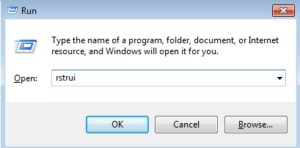
3. Click Next at the first screen.
3. Choose an earlier working state (Date/Time) and click Next to start the restore process.
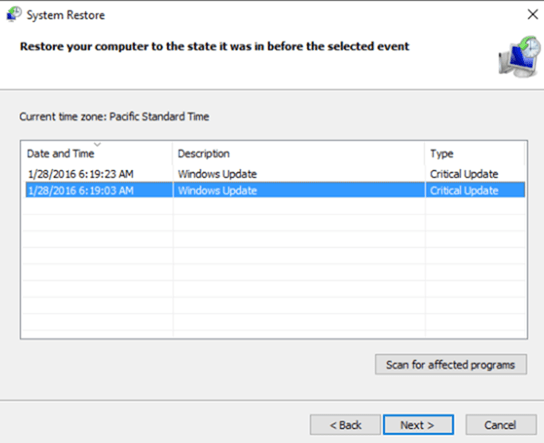
That’s all! Did it work for you?
Please leave a comment in the comment section below or even better: like and share this blog post in the social networks to help spread the word about this solution.
Bài liên quan
- FIX: Error 0x81000203 in System Restore. (Solved)
- Cannot Access Shared folder. User has not been granted the requested logon type at this computer. (Solved)
- FIX: Cannot clear TPM – 0x80284001, 0x80290300 or 0x80290304.
- Unable to Schedule Teams Meeting in 15 or 10 minutes slots (Solved)
- How to Share Folder without Username/Password on Windows 10/11.
- FIX: Thunderbird High CPU or Memory Usage issues.